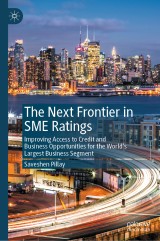Details

The Next Frontier in SME Ratings
Improving Access to Credit and Business Opportunities for the World's Largest Business Segment|
96,29 € |
|
| Verlag: | Palgrave Macmillan |
| Format: | |
| Veröffentl.: | 31.07.2024 |
| ISBN/EAN: | 9783031540158 |
| Sprache: | englisch |
Dieses eBook enthält ein Wasserzeichen.
Beschreibungen
<p>SME credit ratings are one of the most underutilised and misunderstood concepts, though they have the potential to proliferate the ability of SMEs to access funding opportunities via both traditional and non-traditional channels. This book provides a comprehensive overview of the industry and sets out innovative solutions for improving the effectiveness, viability, and coverage of SME credit rating services. It focuses on how private and public sector SME credit rating industries can be established and how the unique “ecosystem approach” can be incorporated. It reintroduces the public sector credit rating model and highlights how it can be an effective solution within the SME space. The book will also include feedback from direct interviews with SME credit rating agencies (private and public), ministries linked to the SME credit rating industry, regulators, and related multilateral organisations. Furthermore, the book incorporates the author’s knowledge from recently completed credit rating projects from the World Bank Group, The United Nations, and The African Union. This, together with innovative ideas around how SME credit rating industries can be created/initiated, establishes vital policy tools that can be utilised by governments, credit rating agencies, regulators, and related stakeholders.<br></p><p></p>
Chapter 1- Introduction.- Chapter 2- An Overview of The SME Industry.- Chapter 3- An Introduction to the “SME Rating”, And Specific “SME Credit Rating” Concepts.- Chapter 4- The benefits of SME ratings.- Chapter 5- An Introduction to The Public Sector Model.- Chapter 6- Practical Applications Of The Public Sector SME Credit Rating Model And Its Associated Benefits.- Chapter 7- Bringing The Public Sector SME Credit Rating Concept into Fruition.- Chapter 8-Creating a private sector credit rating industry.- Chapter 9- An Introduction To The SME Ecosystem Model Approach.- Concluding Remarks.
<b>Saveshen Pillay</b> is the Chief Executive Officer of Credit Rating Analytics. He holds a master’s degree in International Banking & Finance (Cum Laude), a Post Graduate Diploma in Finance, Banking & Portfolio Management, a B. Com Degree in Economics and has completed level 2 of the CFA program. He has led numerous high-level credit rating projects and has worked closely with various divisions within the United Nations, the African Union, the International Finance Corporation, and other key philanthropic organisations. Saveshen’s company has recently contributed to the United Nation’s annual development report on Africa. This report provided insights into how the SME credit rating concept can be used to proliferate funding opportunities within the supply chain finance space and increase transparency within this lending channel. His company also completed a major World Bank Group project related to the SME credit rating industry, and he served as the lead author on the final publications. That specific project was geared towards increasing the awareness of SME credit ratings and coming up with solutions to make it more widely available. Saveshen also serves as an independent director at a subsidiary of one of the world’s largest credit rating agencies.<p></p>
SME credit ratings are one of the most underutilised and misunderstood concepts, though they have the potential to proliferate the ability of SMEs to access funding opportunities via both traditional and non-traditional channels. This book provides a comprehensive overview of the industry and sets out innovative solutions for improving the effectiveness, viability, and coverage of SME credit rating services. It focuses on how private and public sector SME credit rating industries can be established and how the unique “ecosystem approach” can be incorporated. It reintroduces the public sector credit rating model and highlights how it can be an effective solution within the SME space. The book will also include feedback from direct interviews with SME credit rating agencies (private and public), ministries linked to the SME credit rating industry, regulators, and related multilateral organisations. Furthermore, the book incorporates the author’s knowledge from recently completed credit rating projects from the World Bank Group, The United Nations, and The African Union. This, together with innovative ideas around how SME credit rating industries can be created/initiated, establishes vital policy tools that can be utilised by governments, credit rating agencies, regulators, and related stakeholders<p></p><p></p><div><br></div><div><b>Saveshen Pillay</b> is the Chief Executive Officer of Credit Rating Analytics. He holds a master’s degree in International Banking & Finance (Cum Laude), a Post Graduate Diploma in Finance, Banking & Portfolio Management, a B. Com Degree in Economics and has completed level 2 of the CFA program. He has led numerous high-level credit rating projects and has worked closely with various divisions within the United Nations, the African Union, the International Finance Corporation, and other key philanthropic organisations. Saveshen’s company has recently contributed to the United Nation’s annual development report on Africa. This report provided insights into how the SME credit rating concept can be used to proliferate funding opportunities within the supply chain finance space and increase transparency within this lending channel. His company also completed a major World Bank Group project related to the SME credit rating industry, and he served as the lead author on the final publications. That specific project was geared towards increasing the awareness of SME credit ratings and coming up with solutions to make it more widely available. Saveshen also serves as an independent director at a subsidiary of one of the world’s largest credit rating agencies.<br></div>
Analyses the existing SME credit rating industry Offers solutions on how the industry could be optimized Includes interviews with SME credit rating agencies, ministries, regulators and multilateral organisations

















